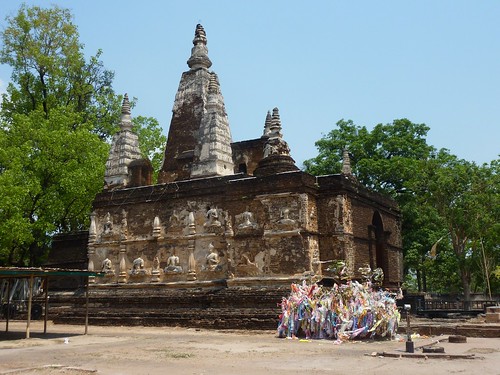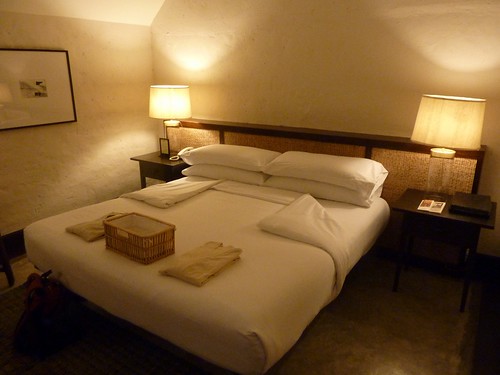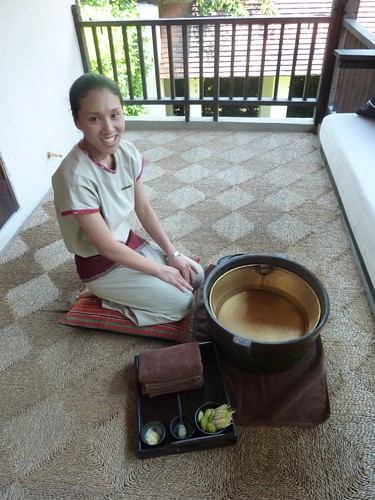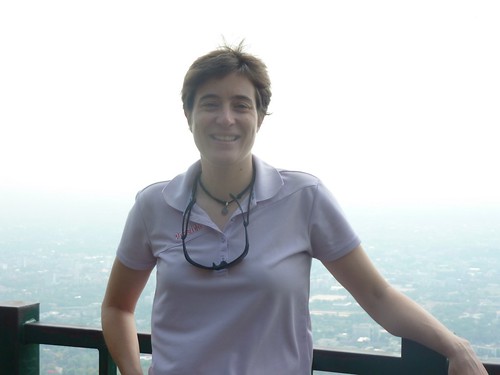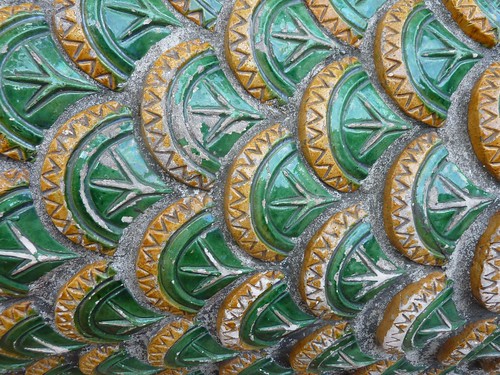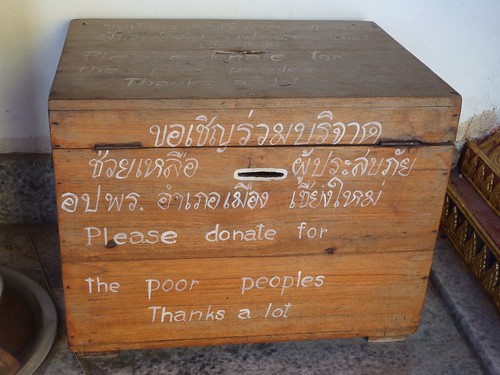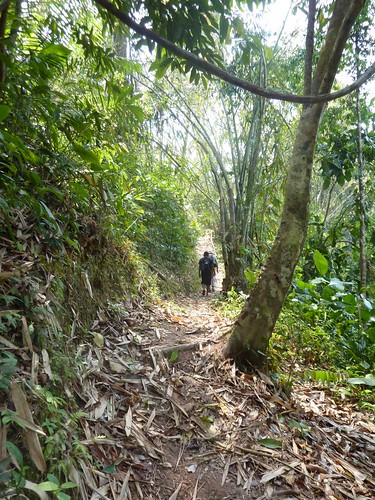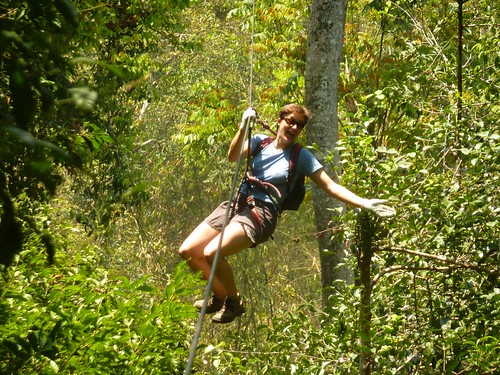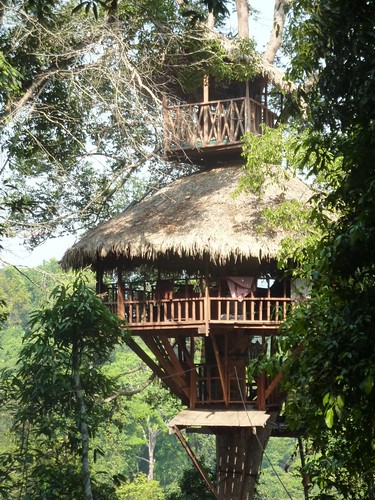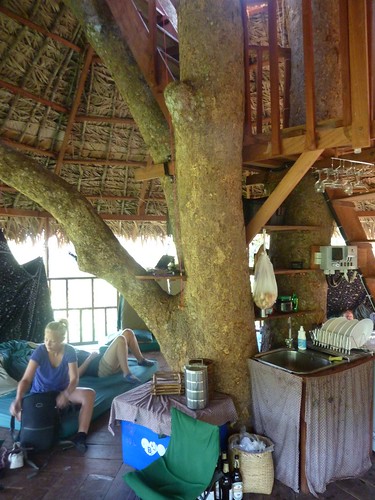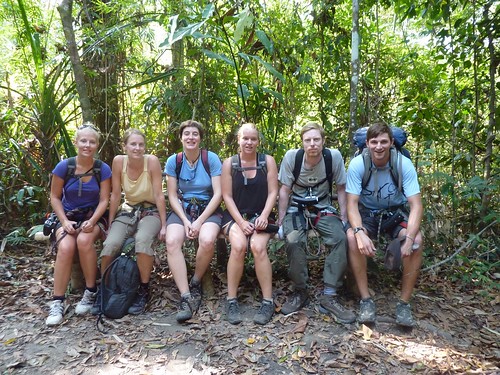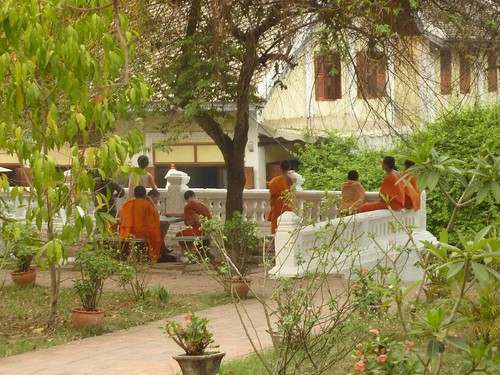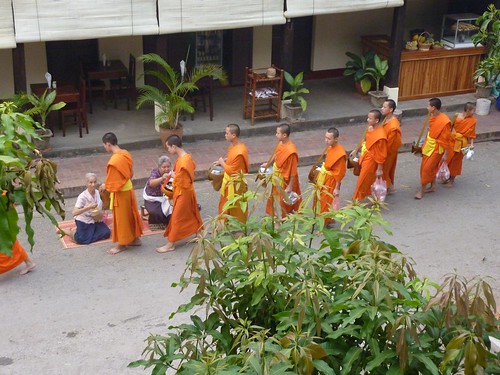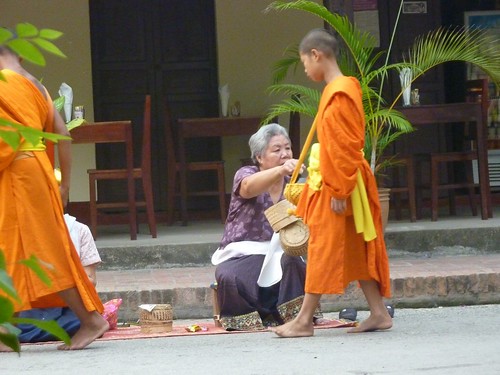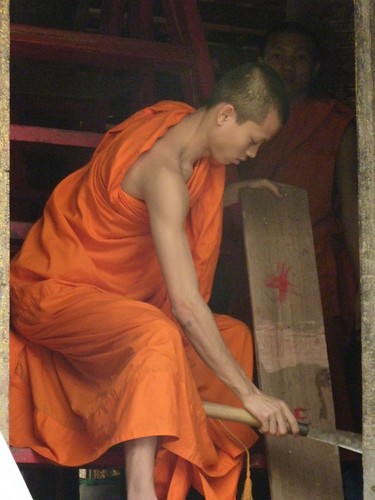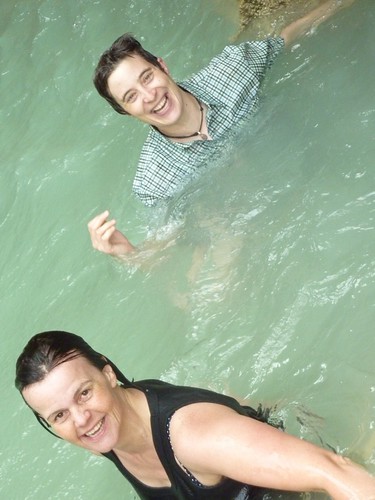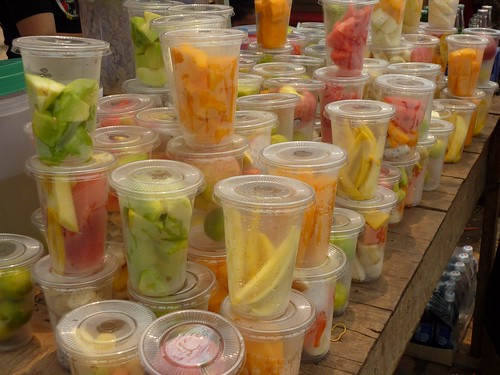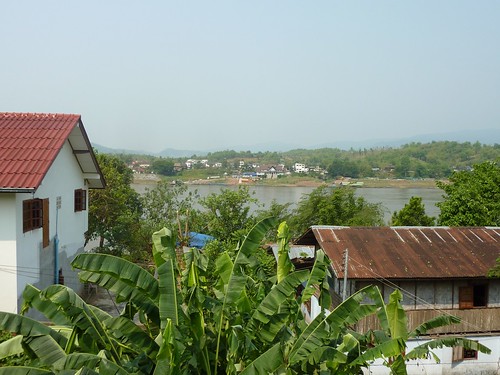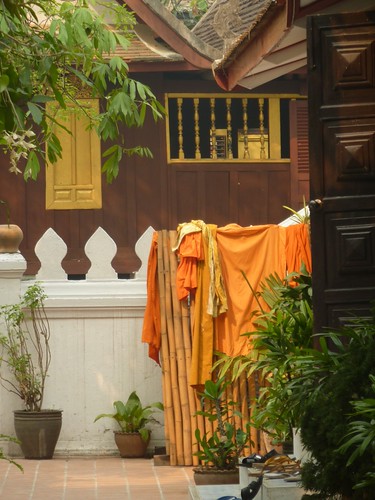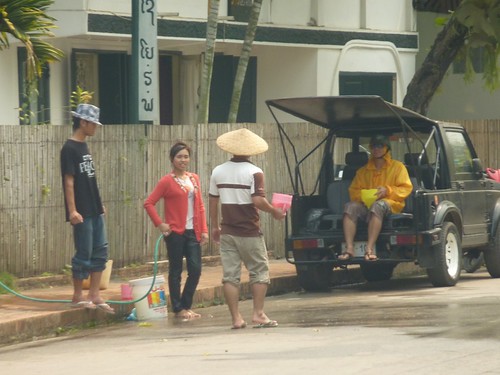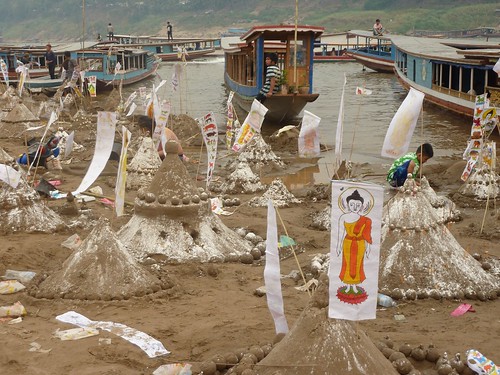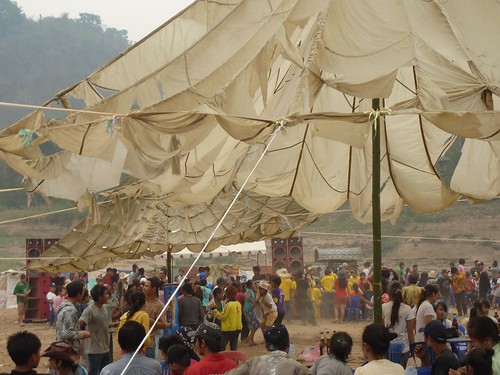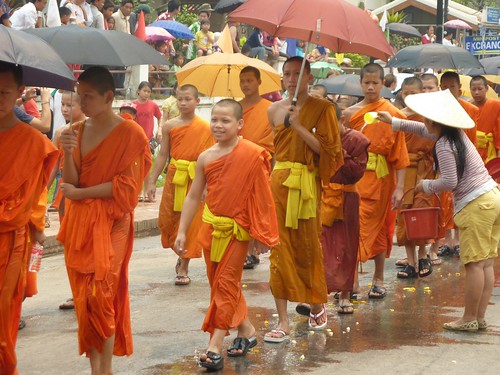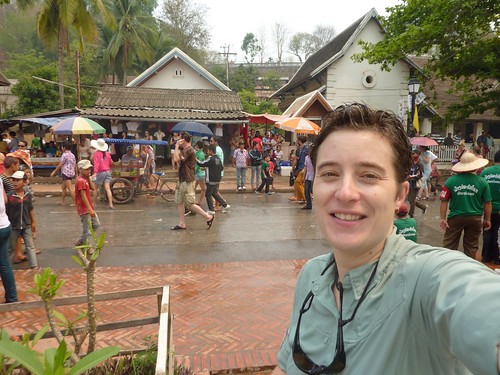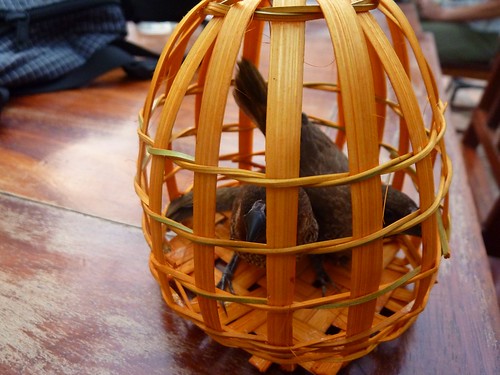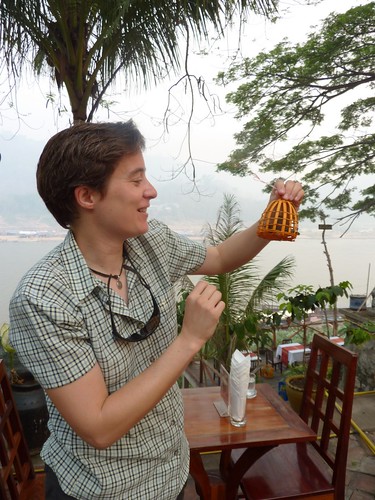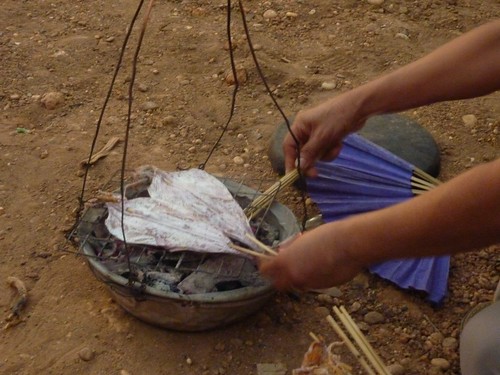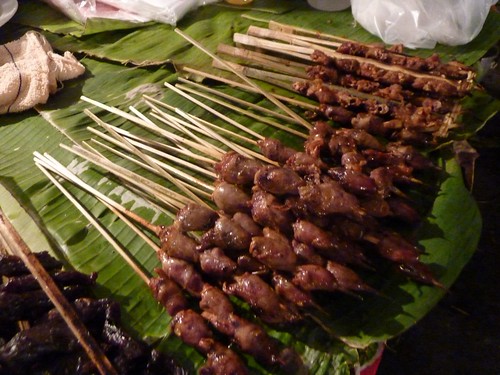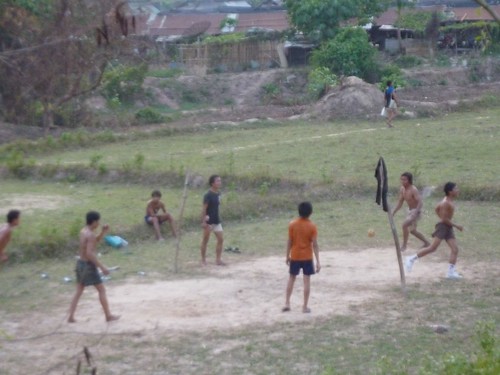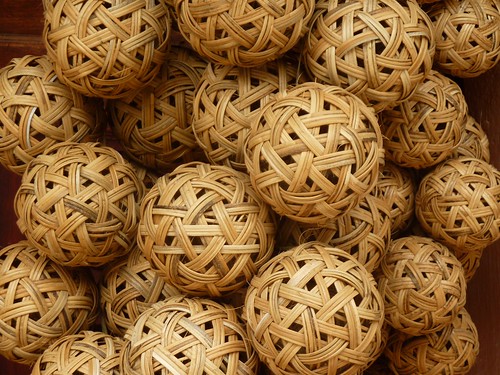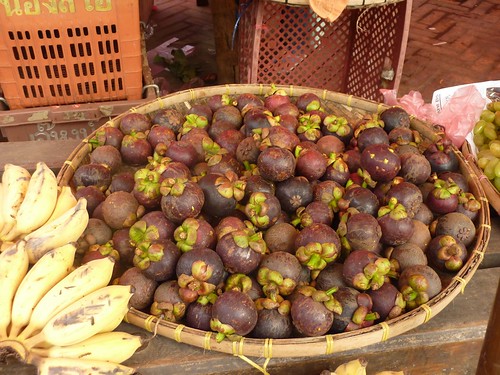Previous blog to the contrary, I did not spend all my time in Chiang Mai lounging around the pool and having massages. As I mentioned, I did go see a big temple, and I hashed, and I even did a bit of shopping. And of course there was weird food. Read on for the details.
The old part of Chiang Mai is a tidy square bounded by a moat and the remains of the city walls that once surrounded it. Both my posh hotel and the not-so-posh-but-still-damned-nice-for-$23-a-night place I moved to were within this area, and it made for easy navigation – both of them were on the main road running from Tha Phae Gate, right in the middle of the eastern side of the moat.
 The moat near Tha Phae Gate. There were fish in that moat. Big, big fish.
The moat near Tha Phae Gate. There were fish in that moat. Big, big fish.
The Chiang Mai Hashers are a well-organized bunch. I’d been in contact with them ahead of time, but even if I hadn’t been it wouldn’t have been hard to find them. Their website is decent, and they have a fixed pickup point (well actually two) that never changes from week to week. All you have to do is find the closest pickup to your location on the handy Google map provided, and show up at the appointed hour. And it doesn’t hurt that the pickup point I chose was a bar called the Hash House, and was conveniently located on the moat near Tha Phae Gate. There was also a big notice board on the wall too, so there was no chance I could think I was in the wrong place.
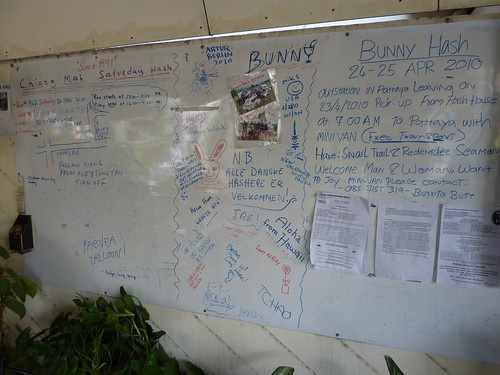 The CMSH3 notice board. Damn, I just realized I forgot to sign it!
The CMSH3 notice board. Damn, I just realized I forgot to sign it!
I rode out to the run in a sawng thaew - a local mini pick-up with bench seats and a canopy – that had a weekly gig just for the hash. Along with me went a couple of local hashers and two gigantic coolers full of water, beer and big blocks of ice. The run was set in a rural area, but unfortunately there’d been a big downpour in between the time the trail was marked and when were were to start. This washed away a lot of the markings, and made the first half of the run a muddy mess, but that’s what hashing is all about, so off we went. Luckily, the hares had the foresight to mark the trail not just with flour but also with small bits of paper weighed down by rocks, so all was not lost.
Once we were through the muddy bit and across a small stream (which served nicely to wash the 7.3 pounds of mud off my shoes), the run turned into a forested area that must recently have been the subject of a controlled burn, because we ran over a lot of charred remains, and even a few bits that were still smoldering, which was a bit eerie. And once again, I chose to run the “Rambo” trail instead of the “Wimp” trail, and once again I regretted that choice almost immediately. I haven’t been feeling in top form for a while now, and had been slow and wheezy for the first half of the run, so in an uncharacteristic fit of lucidity I actually changed my mind and turned back for the Wimp Trail. But of course there was a load of other people heading towards me, Rambo-bound, and I couldn’t really go backwards past all them… So back I went, Rambo all the way. I will not learn.
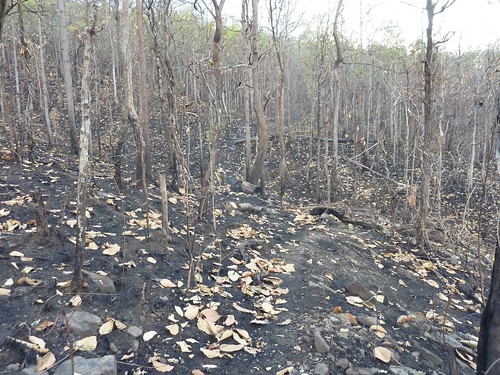 The scenery on trail. Not exactly Hyde Park.
The scenery on trail. Not exactly Hyde Park.
The circle after the run was pretty standard – lots of beer, lots of in-jokes, and lots of people going on too long about lots of things. Much much later we went off to a seafood restaurant and had food and more beer, and it was all lovely. The Sunday “Happy Hash” was much the same, though the run was shorter and the circle was more relaxed. All in all, the Chiang Mai hashers were as friendly and fun a bunch as I’ve met so far, and I was happy to chalk up hashes #22 and 23 with them.
After that Sunday Hash, I got dropped me off right at Tha Phae Gate for the short walk back to the home. (Yes I do think of the hotel, any hotel, as home. Not Home, mind you, but home, at least. You’ve gotta have somewhere.) On Sundays that area is transformed into what’s called the Sunday Walking Street, which is essentially another night market. There are lots of different foods stalls, and people selling local handcrafts, t shirts, knock-off Rolex watches, you name it. (Strangely, there always seem to be a lot of stalls selling men’s underwear in these kind of markets. Call me old-fashioned, but I just don’t think I’d want to buy underwear on the street at eleven o’clock at night on a Sunday.) I wandered happily through the maze of stalls, generally heading in the direction of the hotel, when I had one of those long-term travel weird coincidences - I ran into a load of Danes! Two from good old Tree House 7, and two from way back on the China tour! It turns out that the Danes from TH7 – Christina and Cecilia – were friends with two of the Danes from China – Ditte and Simone – and they’d found each other by chance there in Chiang Mai. And then they found me. It was bizarre and fun, so I wandered with them a bit, and also met up with Todd from the tree house, who was bargaining for a cheap knock-off Rolex for his mom. Very odd, but also fun.
After my weird encounter with the Danes and Todd, I continued towards my hotel. Ever alert for the possibility of weird food, I knew I’d found it when I saw this sign:
 Don’t you just say to yourself sometimes, “Damn, what I really want is some vegetable jelly made by Chinese plant. I hope they have black. And throw some sugar on that baby!”
Don’t you just say to yourself sometimes, “Damn, what I really want is some vegetable jelly made by Chinese plant. I hope they have black. And throw some sugar on that baby!”
I lingered long enough in front of the stall that eventually a young couple who were sampling the product urged me to try it, so I did. My normally immaculate financial record-keeping has let me down here, but I’m pretty sure it was about ฿20, so less than a dollar. And it was… well, it was definitely weird. There were three parts:
- Black jelly. A very very firm jelly, black, that was scraped off a big sort of disk of the stuff yielding spoon-sized shavings that went into the bottom of a styrofoam dish.
- Ice. In large chunks – bigger than crushed, smaller than cubed, placed on top of the jelly
- Sugar. Very coarse dark brown sugar - sprinkled on top of the ice
The friendly couple told me you were supposed to mix it all up, so I did that with the spoon provided. Well I could have mixed that stuff until I got off the plane in Winnipeg on Day 350 and I don’t think it would have helped. The sugar part was ok – sort of like blackstrap molasses in crystallized form. The ice was great; ice never goes amiss in Southeast Asia. Nope, it was the jelly that soured the deal. I’m not sure how to describe the flavour… it was sort of… black. Not blackberry. Not black currant. Just… black. I didn’t realize black had a flavour, but I guess that was it. And rest assured that black is not set to take the flavour world by storm. Do not look for Ben & Jerry’s “Burstin’ Black Beauty Ripple” in your local grocer’s freezer case any time soon. In fact, the whole concoction was so distasteful that it brought on a brief relapse of the vague stomach trouble I’d been having for days. I’ve just started to compile a few “Top Five” lists for the trip – most and least favourite cities, hashes fondly remembered – that kind of thing, and it only took a few spoonfuls for black jelly to secure a firm place on the “Bottom Five Worst Weird Foods” list along with pig ears and worms. And that’s enough said about that.
But fear not! There is also good news on the Weird Food front, because on Monday afternoon I found the Holy Grail that I’d been seeking since Luang Prabang. Yes, kids, I found the eggs-on-a-stick!
 See what I mean? They’re eggs. ON A STICK! Am I the only one who finds this whole concept bizarre and fantastic at the same time? I mean if you had to name one food that manifestly does NOT lend itself to being skewered with a stick, wouldn’t it be an egg?
See what I mean? They’re eggs. ON A STICK! Am I the only one who finds this whole concept bizarre and fantastic at the same time? I mean if you had to name one food that manifestly does NOT lend itself to being skewered with a stick, wouldn’t it be an egg?
Ok, yes, the eggs are hard cooked, but I don’t think that detracts from the pure brilliance of the form, which revealed itself when I got back to the hotel room and cracked open my first skewered egg, still warm from the vendor. As you can (I hope) see in my crummy photo, the interior of a skewered egg is not like that of a regular hard cooked egg. There was no separation between white and yolk at all, leading me to guess that the egg had somehow been scrambled inside the shell before it was cooked. (PPon, these are just made for you!) Tasting further strengthened this determination, because I could swear that the eggs had also been seasoned with salt and pepper. Or perhaps these were just some kind of magical egg that never had a yolk to being with, laid by a creature with salt and pepper running in its veins (anyone who knows anything about these eggs, please chime in). Whatever the source or method, the result was really tasty. Definitely Top Five material.
 Crummy photo, but you can see what I mean. And yes, they were that sort of greeny-bluish colour.
Crummy photo, but you can see what I mean. And yes, they were that sort of greeny-bluish colour.
My last evening in Chiang Mai was spent doing something I haven’t done much of on this trip – shopping! I walked all the way to the main Night Market (not the tetchy Sunday variety) which turned out to be absolutely massive, running for blocks and blocks and blocks. I had my eye on some table-top lantern/lamp thingies that I’d noticed the night before, so it was fun to wander the stalls knowing that eventually I was actually going to buy something, for myself, to keep! After I scouted around a bit I zeroed in on a place that seemed as good as any other. I’m total rubbish at bargaining, but I did manage to get two matching lamps for ฿220 (less than $7.00) not including the light socket. (I figured I’d rather do my own electrical work than rely on potentially dodgey weirdly-plugged, oddly-socketed stuff). I think I got a good deal.
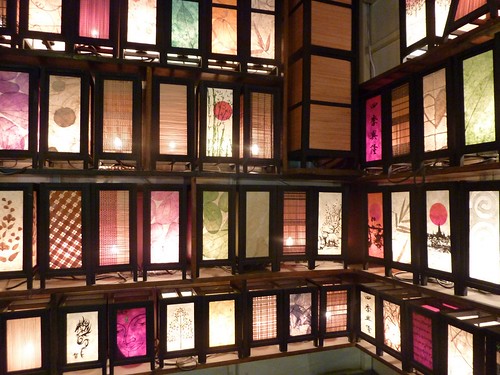 One of the many many many stalls selling the type of lantern I bought
One of the many many many stalls selling the type of lantern I bought
Then I wandered around some more, and had a nice mango shake, and wandered some more, and even thought about buying some more electrical stuff, because I these were really neat:
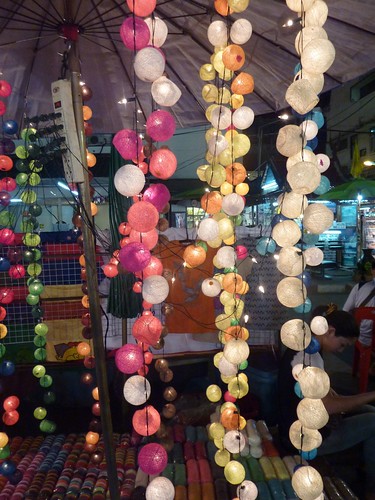 They’re covers for twinkie lights that look like little multi-coloured balls of string. I thought they’d be fun to string up out on a deck, if I still had a deck…
They’re covers for twinkie lights that look like little multi-coloured balls of string. I thought they’d be fun to string up out on a deck, if I still had a deck…
And that’s about it for Chiang Mai. On Tuesday morning I was off to the airport for my flight to Siem Reap, which was a bit of a balls-up because Thai Airways took the liberty of canceling the flight I booked and rebooking me on a flight that arrived in Bangkok too late for me to get my connecting flight to Siem Reap. However they cleared it up when I checked in, and got me on a later connecting flight, so I was left with a few hours to kill in International Airport Land (Bangkok), which was just fine. I did some more shopping to replace my headphones, the last half of which had died on the four hour drive to Chiang Mai (great timing). And I bought a hard copy of the LP Japan, and the LP Japanese phrasebook. It’s the last LP of the trip, folks; the end is coming fast.
But not before I see Angkor Wat, which is next on the list, so don’t touch that dial!


